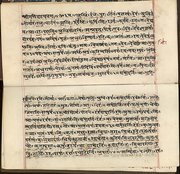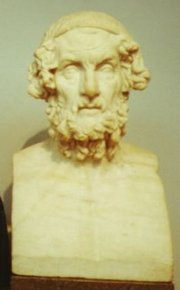Poetry Guide: Poetry
Poetry (ancient Greek: ποιεω (poieo) = I create) is traditionally a written art form (although there is also an ancient and modern poetry which relies mainly upon oral or pictorial representations) in which human language is used for its aesthetic qualities in addition to, or instead of, its notional and semantic content. The increased emphasis on the aesthetics of language and the deliberate use of features such as repetition, meter and rhyme, are what are commonly used to distinguish poetry from prose, but debates over such distinctions still persist, while the issue is confounded by such forms as prose poetry and poetic prose. Some modernists (such as the Surrealists) approach this problem of definition by defining poetry not as a literary genre within a set of genres, but as the very manifestation of human imagination, the substance which all creative acts derive from.
Poetry often uses condensed form to convey an emotion or idea to the reader or listener, as well as using devices such as assonance, alliteration and repetition to achieve musical or incantatory effects. Furthermore, poems often make heavy use of imagery, word association, and musical qualities. Because of its reliance on "accidental" features of language and connotational meaning, poetry is notoriously difficult to translate. Similarly, poetry's use of nuance and symbolism can make it difficult to interpret a poem or can leave a poem open to multiple interpretations.
It is difficult to define poetry definitively, especially when one considers that poetry encompasses forms as different as epic narratives and haiku. Needless to say, many poets have given their own definitions. Carl Sandburg said that, "poetry is the synthesis of hyacinths and biscuits." Robert Frost once said "Poetry is the first thing lost in translation."
Nature of poetry
Poetry can be differentiated from prose, which is language meant to convey meaning in a less condensed way, using more logical or narrative structures. This does not imply poetry is illogical. Poetry is often created from the desire to escape the logical, as well as expressing feelings and other expressions in a tight, condensed manner. English Romantic poet John Keats termed this escape from logic Negative Capability.
Prose poetry combines the characteristics of poetry with the superficial appearance of prose. Other forms include narrative poetry and dramatic poetry, used to tell stories and so resemble novels and plays.
The Greek verb ποιέω [poiéō (= I make or create)], gave rise to three words: ποιητής [poiētḗs (= the one who creates)], ποίησις [poíēsis (= the act of creation)] and ποίημα [poíēma (= the thing created)]. From these we get three English words: poet (the creator), poesy (the creation) and poem (the created). A poet is therefore one who creates and poetry is what the poet creates. The underlying concept of the poet as creator is not uncommon. For example, in Anglo-Saxon a poet is a scop (shaper or maker) and in Scots makar.
Tools
Sound
Perhaps the most vital element of sound in poetry is rhythm. Often the rhythm of each line is arranged in a particular meter. Different types of meter played key roles in Classical, Early European, Eastern and Modern poetry. In the case of free verse, the rhythm of lines is often organized into looser units of cadence. Robinson Jeffers, Marianne Moore, and William Carlos Williams were three notable poets who rejected the idea that meter was a critical element of poetry, claiming it was an unnatural imposition into poetry.
Poetry in English and other modern European languages often uses rhyme. Rhyme at the end of lines is the basis of a number of common poetic forms, such as ballads, sonnets and rhyming couplets. However, the use of rhyme is not universal. Much modern poetry avoids traditional rhyme schemes. Classical Greek and Latin poetry did not use rhyme. Rhyme did not enter European poetry until the High Middle Ages, when adopted from the Arabic language. Arabs have always used rhymes extensively, most notably in their long, rhyming qasidas. Some classical poetry forms, such as Venpa of the Tamil language, had rigid grammars (to the point that they could be expressed as a context-free grammar), which ensured a rhythm. Alliteration played a key role in structuring early Germanic and English forms of poetry, alliterative verse. The alliterative patterns of early Germanic poetry and the rhyme schemes of Modern European poetry include meter as a key part of their structure, which determines when the listener expects instances of rhyme or alliteration to occur. Alliteration and rhyme, when used in poetic structures, help emphasise and define a rhythmic pattern. By contrast, the chief device of Biblical poetry in ancient Hebrew was parallelism, a rhetorical structure in which successive lines reflected each other in grammatical structure, sound structure, notional content, or all three; which lent itself to antiphonal or call-and-response performance.
Sound plays a more subtle role in free verse poetry by creating pleasing, varied patterns and emphasizing or illustrating semantic elements of the poem. Alliteration, assonance, consonance, dissonance and internal rhyme are among the ways poets use sound. Euphony refers to the musical, flowing quality of words arranged in an aesthetically pleasing way.
Form
Poetry depends less on linguistic units of sentences and paragraphs. The structural elements are the line, couplet, strophe, stanza, and verse paragraph.
Lines may be self-contained units of sense, as in the well-known lines from William Shakespeare's Hamlet:
- To be, or not to be: that is the question.
Alternatively a line may end in mid-phrase or sentence:
- Whether 'tis nobler in the mind to suffer
this linguistic unit is completed in the next line,
- The slings and arrows of outrageous fortune.
This technique is called enjambment, and is used to create expectation, adding dynamic tension to the verse.
In many instances, the effectiveness of a poem derives from the tension between the use of linguistic and formal units. With the advent of printing, poets gained greater control over the visual presentation of their work. As a result, the use of these formal elements, and of the white space they help create, became an important part of the poet's toolbox. Modernist poetry tends to take this to an extreme, with the placement of individual lines or groups of lines on the page forming an integral part of the poem's composition. In its most extreme form, this leads to concrete poetry.
Rhetoric
Rhetorical devices such as simile and metaphor are frequently used in poetry. Aristotle wrote in his Poetics that "the greatest thing by far is to be a master of metaphor". Since the rise of Modernism, some poets have opted for reduced use of these devices, attempting the direct presentation of things and experiences. Surrealists have pushed rhetorical devices to their limits, making frequent use of catachresis.
History
Poetry as an art form predates literacy. Poetry was employed as a means of recording oral history, storytelling (epic poetry), genealogy, and law. Poetry is often closely identified with liturgy in pre-literate societies. Many of the scriptures currently held to be sacred by contemporary religious traditions with their roots in antiquity were composed as poetry rather than prose to aid memorization and help guarantee the accuracy of oral transmission in pre-literate societies. As a result many of the poems surviving from the ancient world are a form of recorded cultural information about the people of the past, and their poems are prayers or stories about religious subject matter, histories about their politics and wars, and the important organizing myths of their societies.
 Manuscript of the Rig Veda, Sanskrit verse composed in the 2nd millennium BC.
Manuscript of the Rig Veda, Sanskrit verse composed in the 2nd millennium BC.
The use of verse to transmit cultural information continues today. Many English-speaking Americans know that "in 1492, Columbus sailed the ocean blue". An alphabet song teaches the names and order of the letters of the alphabet; another jingle states the lengths and names of the months in the Gregorian calendar. Some writers believe poetry has its origins in song. Most of the characteristics that distinguish it from other forms of utterance—rhythm, rhyme, compression, intensity of feeling, the use of refrains—appear to have come about from efforts to fit words to musical forms. In the European tradition the earliest surviving poems, the Homeric and Hesiodic epics, identify themselves as poems to be recited or chanted to a musical accompaniment rather than as pure song. Another interpretation is that rhythm, refrains, and kennings are essentially paratactic devices that enable the reciter to reconstruct the poem from memory.
In preliterate societies, these forms of poetry were composed for, and sometimes during, performance. There was a certain degree of fluidity to the exact wording of poems. The introduction of writing fixed the content of a poem to the version that happened to be written down and survive. Written composition meant poets began to compose for an absent reader. The invention of printing accelerated these trends. Poets were now writing more for the eye than for the ear.
 Bust of Homer, one of the earliest European poets, in the British Museum
Bust of Homer, one of the earliest European poets, in the British Museum
The development of literacy gave rise to more personal, shorter poems intended to be sung. These are called lyrics, which derives from the Greek lura or lyre, the instrument that was used to accompany the performance of Greek lyrics from about the seventh century BC onward. The Greek's practice of singing hymns in large choruses gave rise in the sixth century BC to dramatic verse, and to the practice of writing poetic plays for performance in their theatres. In more recent times, the introduction of electronic media and the rise of the poetry reading have led to a resurgence of performance poetry. The late 20th-century rise of the singer-songwriter, Rap culture, and the increase in popularity of Slam poetry have led to a split between the academic and popular views.
Terms
Periods, styles and movements- For movements see List of schools of poetry.
Technical means
Tropes
- Metaphor
- Simile
- Irony
- Metonymy
- Synecdoche
- Ellipsis
Measures of verse
| Types of metre | Types of line |
|---|---|
|
External links
Reference material and resources- Poetry Definitions from poetrymagic.co.uk
- Library of Congress Poetry Resources
- Favorite Poem Project
- Recorded poems and interviews at Wired for Books - RealAudio
Poetry collections and anthologies
- Poetry eTexts at Project Gutenberg
- The HyperTexts has poetry by the Masters, contemporary poets, Esoterica, essays, and more
- Representative Poetry Online
- Bartleby Verse
- Cosmoetica: Hundreds of poems, and essays on poetry
- Vast Collection of Poems sorted by Subject and Poet
- Oldpoetry.com: Classical poetry archives and discussion.
- Plagiarist.com
- Poetry X: 10,000+ classic and contemporary poems
- AfroPoets Famous Black Writers
- Starbuck:Classical Poetry
Poetry organizations and publications
- Academy of American Poets
- Poets & Writers: American poetry and writing magazine
- Poetry Magazine
- American Poetry Review
- Contemporary Poetry Review
- Miami Poetry Review
Poetry Kaleidoscope: Guide to Poetry made by MultiMedia Free content and software
This guide is licensed under the GNU Free Documentation License. It uses material from Wikipedia.

